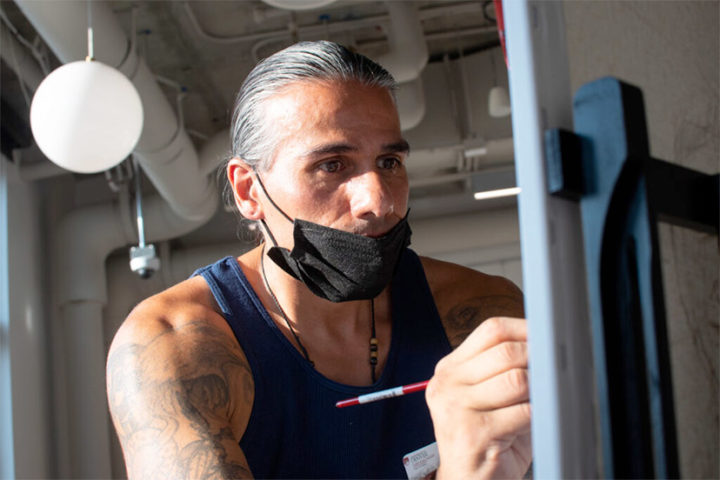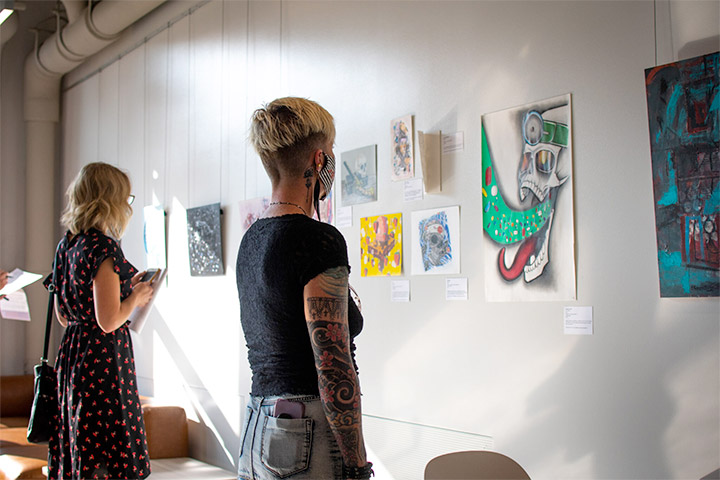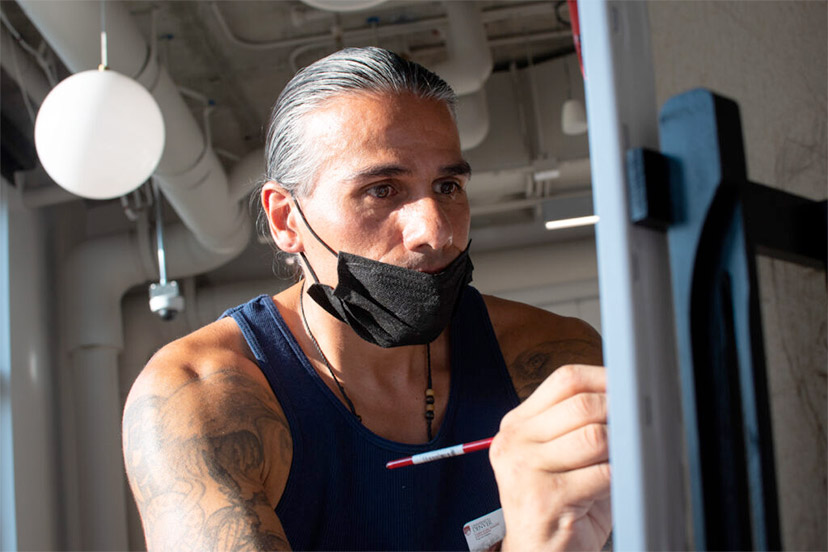This article is excepted from the story by Moe Clark posted on Colorado Newsline on August 23, 2021. Read the full story here.
As people shuffled in and out of a tiny art gallery at the University of Denver, Jerry Martinez stood off to the side, diligently working on an oil painting as the setting sun beat down on him.
“I’ve been doing art since I can remember,” 42-year-old Martinez said. “I remember picking up a pencil and finding paper when I was 3, 4 years old, and just drawing anything and everything I could find.”
Though he’s created art throughout his life, he never thought he would have the opportunity to share it with the world. After being convicted of a crime at age 17, he spent 25 years in state prison. He was recently released through a program for people who were convicted as juveniles.

Jerry Martinez, who has been creating art most of his life, paints a portrait of his friend during the “Chained Voices” art showcase at the University of Denver on August 20, 2021. Photos by Moe Clark/Colorado Newsline.
On August 20, he got an opportunity he never expected: to see his peers’ artwork on display during the “Chained Voices” showcase at the University of Denver. The showcase is part of a broader partnership between DU and the Colorado Department of Corrections to change prison culture and empower incarcerated people to find meaning, and purpose, through art.
For Martinez, art has always been a way for him to create something that could never be taken away.
“I thought I’d never get out. So I always thought to myself, well, if in 50, 60 years after I’m gone, somebody sees [my art], well, I’m still going. I’m still out there in the world somewhere, somehow,” said Martinez, who became a team leader for the DU Prison Arts Initiative program while he was incarcerated at the Four Mile Correctional Facility, a state prison located in Cañon City.
He said the program opened up doors for him. Since getting out of prison five months ago, it’s been hard for him to find time to create art while working and trying to get accustomed to his new life. But he’s working to save up money to buy more art supplies to continue to pursue his passion.
“DU opened up avenues that were so cut off for people, and they opened up the avenues to show that we can do it, we can do it if we want to,” Martinez said, who is also now a published playwright. “If we work for it and we do things and apply ourselves, we can make something of ourselves.”
“It’s so crazy to see a shift in the world where people are starting to say, ‘Hey, you’ve done something, we get that, but can you be better than that?’” he added. “‘Can you live a different life now?’ And it’s amazing that the opportunities are being given.”

Dean Williams, director of the Department of Corrections, said the art showcase represents one aspect of what he calls “normalization.” Since assuming his role in 2019, Williams has been on a mission to make Colorado prisons less punitive and more rehabilitative.
“The reality is, we have such a long ways to go,” he said, as he sat in the middle of the art gallery. “Sometimes it seems like a formidable task to say that prisons can be different, that they can be more humane, safer for inmates, safer for staff, and be more purpose-driven.”
But he said efforts like DU Prison Arts Initiative are helping to push the status quo.
“I really view it as my job to create spaces where work is being made, whether that’s theater storytelling, fine arts, radio/audio work, whatever it is, that reminds us of who’s really inside,” said Ashley Hamilton, co-founder and executive director of the DU Prison Arts Initiative. “That folks inside are full humans, and are really complicated, just like us.”
Over the last few weeks, Hamilton, who is an assistant professor of theater at DU, has been teaching a workshop alongside six incarcerated men from Sterling Correctional Facility, a state prison in northeast Colorado. The workshops focus on restorative and transformative justice, using art as the vehicle.
“What I’m seeing happen in these workshops is utterly mind blowing,” Hamilton told the crowd during a panel discussion on August 20. “Bringing staff and incarcerated people into a room and using art for them to connect on their humanity, is doing something that I don’t even have words for yet.”
“That is the heartbeat, I believe, of the change of prison culture,” she added.
Williams said Colorado’s prison culture has come a long way in just a few short years. He recalled a time when a woman stood up during a community meeting in Alaska — where he was the commissioner of corrections — to say she didn’t agree with the changes he was suggesting, and that the answer was to make prisons “hell holes” so that no one would want to go there.
That’s why when Hamilton approached him early in his tenure in Colorado regarding the DU Prison Arts Initiative, he jumped in with both feet. Williams said the DU Prison Arts Initiative programs are helping to convince both staff and incarcerated people that a better way exists.
“I’m not sure if we’ll be able to articulate it tonight, but what’s happening in prisons because of this work is profound, more profound than any prison program,” Williams said. “But we’re becoming a bellwether of really what the future can be.”

